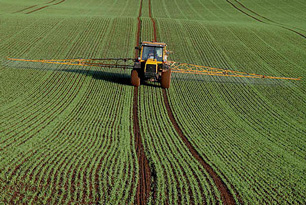Simazine
| EPA Maximum Contaminant Level (MCL) |
0.004 mg/L |

Simazine is an organic chemical used as an herbicide to control broad-leafed and grassy weeds. It's used on a wide range of crops and non-crops, according to the World Health Organization: “artichokes, asparagus, berries, broad beans, citrus fruits, coffee, cocoa, hops, [corn], oil palms, olives, orchards, ornamentals, sugar-cane, tea, tree nurseries, turf, and vineyards, as well as in non-crop areas.”
Simazine arrives in drinking water primarily through runoff from its herbicidal uses.
Health Effects of Simazine
Simazine is not acutely toxic via oral exposure, but the World Health Organization reports that simazine has caused dermatological reactions in factory workers exposed via skin contact. The EPA warns that long term oral exposure could lead to blood issues:
Some people who drink water containing simazine well in excess of the maximum contaminant level [0.004 milligrams per Liter] for many years could experience problems with their blood.
Water Treatment for Simazine
The EPA recommends granular activated carbon (GAC) for the treatment of simazine.
Sources: EPA, EPA (2), WHO, EXTOXNET, Photo: geograph.org.uk, author: Walter Baxter
Site Index
Filtration Systems
- Aeration for Iron & Sulfide
- Backwashing Filters
(whole house & well units)
- Chlorine & Chemical Injectors
- Countertop Water Filters
- Emergency Filters
- Garden Hose Filters
- Reverse Osmosis, Residential
- Reverse Osmosis, Commercial
- Shower Filters
- Specialty Filters
- Ultraviolet Systems
- Undersink Filters
- Water Softeners
- Whole House Filters
Cartridges
Parts
- Replacement Parts
- Faucets
- Filter Media
- Fittings
- Housings
- O-rings
- Pumps
- Pura UV
- R.O. Parts
- R.O. Tanks
- R.O. Booster Pump
- VIQUA UV